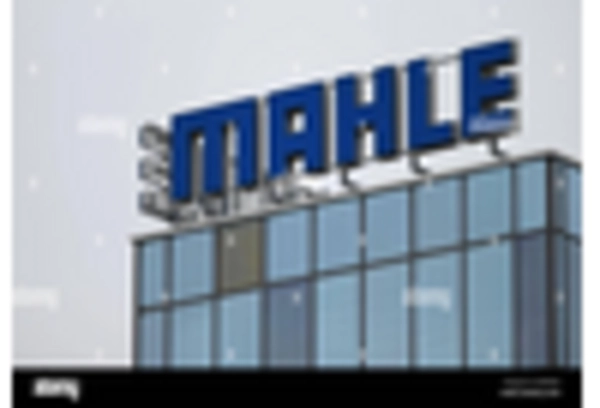Rising Vehicle Production
The automotive industry is experiencing a notable increase in vehicle production, which directly influences the Automotive Coolant Reservoir Tank Market. As manufacturers ramp up production to meet consumer demand, the need for efficient cooling systems becomes paramount. In 2025, vehicle production is projected to reach approximately 90 million units, a figure that underscores the growing requirement for coolant reservoir tanks. This surge in production not only drives demand for coolant reservoir tanks but also encourages innovation in materials and designs, as manufacturers seek to enhance performance and durability. Consequently, the Automotive Coolant Reservoir Tank Market is likely to benefit from this upward trend, as more vehicles on the road necessitate reliable cooling solutions.
Growth of Aftermarket Services
The aftermarket services sector is witnessing substantial growth, which is positively influencing the Automotive Coolant Reservoir Tank Market. As vehicles age, the need for replacement parts, including coolant reservoir tanks, becomes increasingly important. In 2025, the aftermarket segment is expected to account for nearly 40% of the total automotive parts market, highlighting the potential for coolant reservoir tank sales in this sector. This trend is driven by a growing awareness among consumers regarding vehicle maintenance and the importance of using quality replacement parts. Consequently, the Automotive Coolant Reservoir Tank Market stands to gain from this shift, as more vehicle owners seek reliable and efficient cooling solutions to prolong the lifespan of their vehicles.
Regulatory Compliance and Standards
The automotive industry is facing increasingly stringent regulatory compliance and standards, which are influencing the Automotive Coolant Reservoir Tank Market. Governments worldwide are implementing regulations aimed at reducing emissions and enhancing vehicle safety, necessitating the use of high-quality coolant reservoir tanks that meet these standards. In 2025, it is projected that compliance-related costs will rise, prompting manufacturers to invest in advanced cooling technologies. This trend not only drives demand for compliant coolant reservoir tanks but also encourages innovation in design and materials to meet regulatory requirements. As a result, the Automotive Coolant Reservoir Tank Market is likely to see growth as manufacturers adapt to these evolving standards and consumer expectations.
Increasing Focus on Engine Efficiency
The automotive sector is increasingly prioritizing engine efficiency, which has a direct impact on the Automotive Coolant Reservoir Tank Market. As manufacturers strive to meet stringent emissions regulations and improve fuel economy, the role of coolant reservoir tanks becomes more critical. Efficient cooling systems are essential for maintaining optimal engine temperatures, thereby enhancing performance and reducing emissions. In 2025, it is estimated that the demand for high-performance coolant systems will grow by approximately 15%, reflecting the industry's commitment to sustainability and efficiency. This focus on engine performance not only drives innovation in coolant reservoir tank designs but also expands the market as manufacturers seek advanced solutions to meet evolving consumer expectations.
Technological Innovations in Materials
Technological advancements in materials science are significantly shaping the Automotive Coolant Reservoir Tank Market. The introduction of lightweight, durable materials such as advanced polymers and composites is enhancing the performance and longevity of coolant reservoir tanks. These innovations not only improve the efficiency of cooling systems but also contribute to overall vehicle weight reduction, which is a critical factor in enhancing fuel efficiency. In 2025, it is anticipated that the market for advanced materials in automotive applications will grow by approximately 20%, indicating a strong trend towards adopting innovative solutions. As manufacturers increasingly incorporate these materials into their designs, the Automotive Coolant Reservoir Tank Market is likely to experience a surge in demand for high-performance, lightweight coolant reservoir tanks.


















Leave a Comment